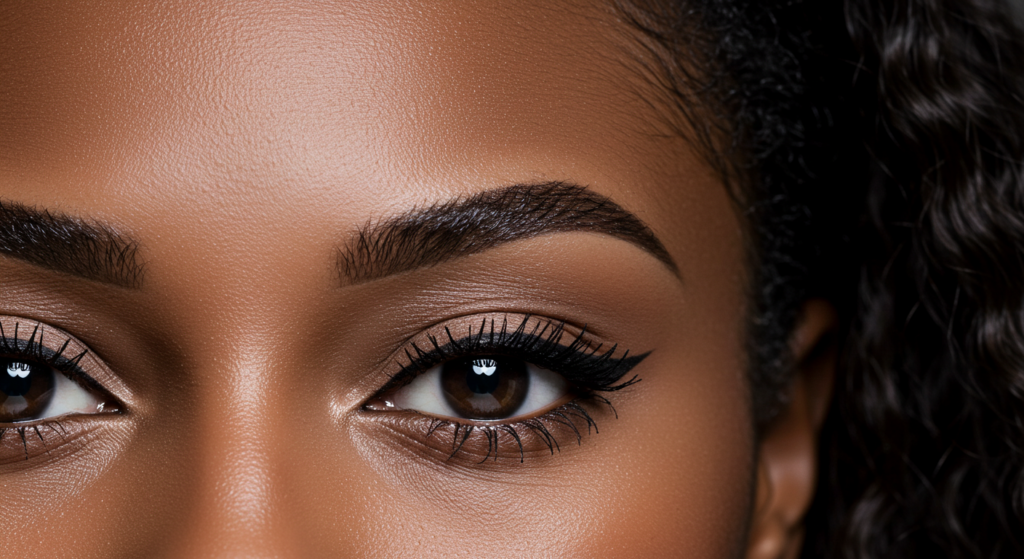As a facial plastic surgeon, Dr. MFO, I have the privilege of helping individuals achieve their aesthetic goals and enhance their natural beauty. Among the various procedures I perform, eye feminization and canthal tilt correction stand out as particularly impactful in transforming one’s appearance. The eyes, often referred to as the “windows to the soul,” play a crucial role in how we perceive attractiveness and express emotions. Subtle changes in their shape and orientation can significantly influence the overall femininity and harmony of the face.
In this comprehensive blog post, we will delve deep into the fascinating world of eye feminization and canthal tilt. We will explore the anatomical nuances that define feminine eye aesthetics, understand the concept of canthal tilt and its significance, discuss the surgical and non-surgical approaches to achieving a more feminine eye shape, and address common questions and concerns. Whether you are considering these procedures or simply curious about the intricacies of facial aesthetics, this guide will provide you with valuable insights.
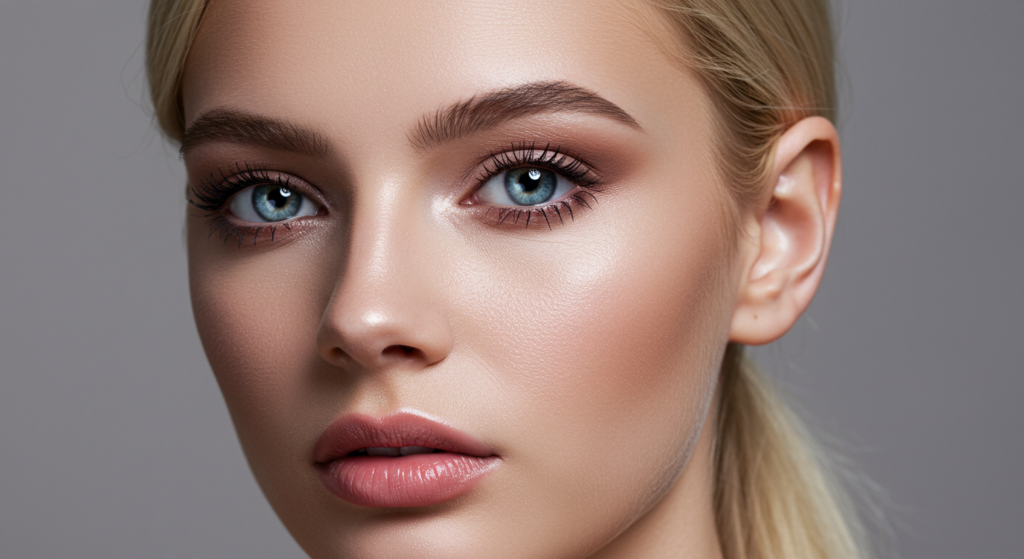
Table of Contents
Understanding Feminine Eye Aesthetics: More Than Just Shape
When we talk about feminine eyes, we often envision a certain softness, openness, and allure. While the overall shape certainly matters, several factors contribute to this perception. These include:
- The Canthal Tilt: This refers to the angle of the line connecting the inner and outer corners of the eye. A slightly upward tilt, often referred to as a positive canthal tilt, is generally considered a hallmark of feminine and youthful eyes.
- Eyelid Hooding: The amount of skin that folds over the upper eyelid can influence the perceived openness and youthfulness of the eyes. Excessive hooding can make the eyes appear smaller and heavier.
- Brow Position: The position and shape of the eyebrows play a crucial role in framing the eyes. Higher, more arched brows are often associated with femininity.
- Lower Eyelid Shape and Support: The contour and tightness of the lower eyelid contribute to the overall shape and appearance of the eyes. A smooth, well-supported lower eyelid is generally considered more aesthetically pleasing.
- Tear Trough Definition: The tear trough is the natural depression between the lower eyelid and the cheek. A well-defined tear trough can enhance the youthful appearance of the eyes, while deep or shadowed troughs can create a tired look.
- Eyelash Length and Fullness: While not directly related to the surgical aspects we’ll discuss, longer and fuller eyelashes are often associated with femininity and can further enhance the beauty of the eyes.
It’s important to understand that the perception of beauty is subjective and can vary across cultures and individuals. However, these general characteristics are often observed in individuals considered to have feminine and attractive eyes.
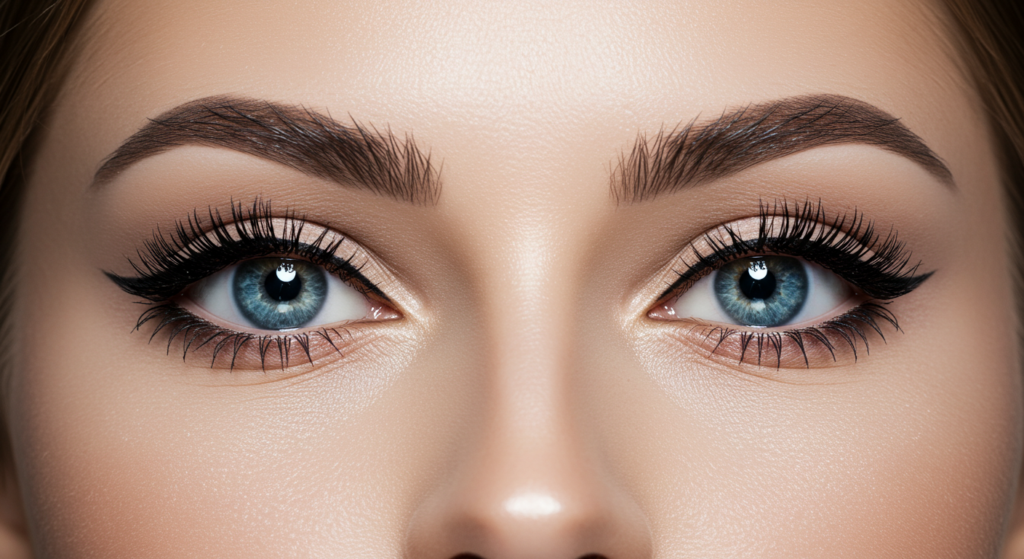
What is Canthal Tilt? Defining the Angle of Allure
The canthal tilt is a fundamental concept in understanding eye shape and its impact on facial aesthetics. It is defined as the angle formed by the line connecting the medial canthus (the inner corner of the eye) and the lateral canthus (the outer corner of the eye) relative to a horizontal line.
- Positive Canthal Tilt (Upturned): In a positive canthal tilt, the lateral canthus sits slightly higher than the medial canthus. This upward slant is often associated with youthfulness, attractiveness, and femininity. It creates an “almond-shaped” appearance and can contribute to a more alert and engaging look.
- Neutral Canthal Tilt (Level): In a neutral canthal tilt, the medial and lateral canthi are roughly at the same horizontal level.
- Negative Canthal Tilt (Downturned): In a negative canthal tilt, the lateral canthus sits lower than the medial canthus. This downward slant can sometimes be perceived as making the eyes look tired, sad, or even stern.
The degree of canthal tilt can vary significantly among individuals due to genetics and aging. As we age, the supporting structures around the eyes can weaken, leading to a gradual flattening or even a downward tilt of the lateral canthus.
The Significance of Canthal Tilt in Feminine Beauty: Why the Upward Slant Matters
The upward canthal tilt is often considered a key feature of feminine beauty for several reasons:
- Youthful Appearance: The natural tendency for a positive canthal tilt in younger individuals contributes to a more youthful and vibrant appearance. As we age and the skin and tissues around the eyes lose elasticity, the lateral canthus can droop, leading to a less youthful look.
- Almond Shape: The upward tilt helps create the classic “almond shape” of the eyes, which is widely considered aesthetically pleasing and feminine. This shape is often associated with grace and elegance.
- Open and Alert Look: A positive canthal tilt can make the eyes appear more open, alert, and engaging. It can also contribute to a brighter and more approachable facial expression.
- Harmonious Facial Balance: The upward slant of the eyes can contribute to a more balanced and harmonious overall facial appearance, complementing other feminine features.
While a positive canthal tilt is generally considered desirable for a feminine aesthetic, it’s important to note that the ideal degree of tilt can vary depending on individual facial structure and preferences. The goal is to achieve a natural and balanced look that enhances the individual’s unique beauty.
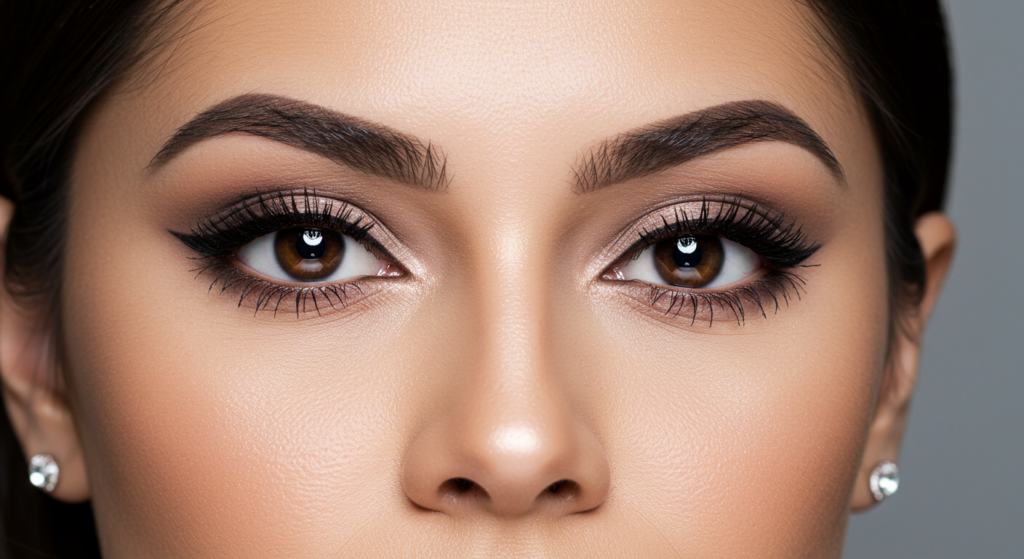
Eye Feminization: A Comprehensive Approach Beyond Canthal Tilt
While canthal tilt is a significant aspect of eye feminization, the overall process often involves addressing other factors to achieve a more comprehensively feminine appearance. These may include:
- Addressing Upper Eyelid Hooding (Blepharoplasty): Excess skin and fat in the upper eyelids can create a hooded appearance, making the eyes look smaller and heavier. Upper blepharoplasty is a surgical procedure to remove this excess tissue, resulting in a more open and youthful look. This can significantly contribute to eye feminization by revealing more of the upper eyelid and making the eyes appear brighter.
- Brow Lift: The position of the eyebrows significantly impacts the overall appearance of the eyes. Lowered or flattened brows can make the upper eyelids appear heavier and less feminine. A brow lift can elevate the eyebrows to a more youthful and feminine position, opening up the eye area and creating a more defined arch. Different brow lift techniques exist, including endoscopic brow lift and temporal brow lift, and the best approach depends on the individual’s anatomy and desired outcome.
- Lower Eyelid Enhancement: The shape and support of the lower eyelids are also important for overall eye aesthetics. Procedures like lower blepharoplasty can address puffiness and excess skin under the eyes. In some cases, tightening the lower eyelid (canthopexy) may be necessary to improve support and prevent a rounded or scleral show appearance (where too much of the white of the eye below the iris is visible).
- Tear Trough Filler: While not a surgical procedure, dermal fillers can be used to address the tear trough deformity, reducing shadows and creating a smoother transition between the lower eyelid and the cheek. This can contribute to a more rested and youthful appearance of the eyes.
- Lateral Canthoplasty for Canthal Tilt: As we will discuss in detail, lateral canthoplasty is a surgical procedure specifically designed to elevate the lateral canthus and create a more positive canthal tilt.
The specific combination of procedures will depend on the individual’s unique anatomy, aesthetic goals, and the surgeon’s assessment. A comprehensive approach to eye feminization aims to create a harmonious and natural-looking result that enhances the overall femininity of the face.

Surgical Techniques for Canthal Tilt Adjustment: Canthoplasty and Canthopexy
When it comes to surgically adjusting the canthal tilt, two primary procedures are commonly performed: canthoplasty and canthopexy. While both procedures involve the lateral canthus, they differ in their approach and the extent of the change they can achieve.
Canthoplasty: Reshaping the Outer Corner
Canthoplasty is a more involved surgical procedure that involves releasing and repositioning the lateral canthal tendon, which supports the outer corner of the eye. This allows for a significant change in the shape and tilt of the eye.
- The Procedure: During a canthoplasty, the surgeon makes a small incision in the outer corner of the eyelid crease. The lateral canthal tendon is then carefully identified and released from its attachment to the orbital bone. The tendon is then repositioned and secured at a higher or lower position, depending on the desired outcome. Excess skin in the area may also be removed. The incision is then closed with fine sutures.
- Goals of Canthoplasty: The primary goals of canthoplasty include:
- Elevating the lateral canthus to create a more positive canthal tilt (for feminization or to address age-related drooping).
- Lengthening the horizontal aperture of the eye (making the eyes appear wider).
- Changing the overall shape of the eye, often creating a more almond-shaped appearance.
- Recovery: Recovery after canthoplasty typically involves some swelling and bruising around the eyes, which can last for several days to a few weeks. Patients are usually advised to avoid strenuous activities and follow specific post-operative care instructions.
Canthopexy: Supporting the Outer Corner
Canthopexy is a less invasive procedure that focuses on supporting and tightening the lateral canthal tendon without fully releasing it. It is often used to address mild drooping of the outer corner of the eye or to provide additional support during other eyelid surgeries, such as lower blepharoplasty.
- The Procedure: In a canthopexy, the surgeon makes a small incision in the outer corner of the eyelid crease. The lateral canthal tendon is then identified and tightened by suturing it to the underlying periosteum (the membrane covering the orbital bone). This helps to elevate and stabilize the outer corner of the eye.
- Goals of Canthopexy: The primary goals of canthopexy include:
- Providing mild elevation to the lateral canthus.
- Tightening the lower eyelid to improve support and prevent scleral show.
- Preventing downward migration of the lateral canthus during or after other eyelid surgeries.
- Recovery: Recovery after canthopexy is generally shorter and less involved than after canthoplasty, with less swelling and bruising.
Choosing the Right Procedure
The choice between canthoplasty and canthopexy depends on the individual’s specific needs and the desired outcome. Canthoplasty is typically recommended for individuals seeking a more significant change in canthal tilt and eye shape, while canthopexy is better suited for mild elevation and support. During your consultation with Dr. MFO, a thorough assessment will be performed to determine the most appropriate surgical technique to achieve your aesthetic goals.
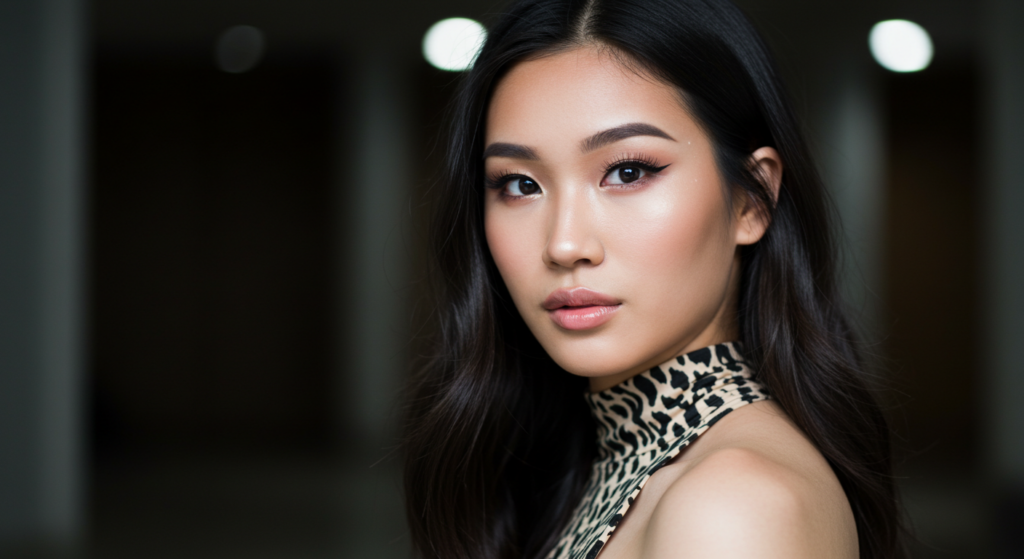
Who is a Good Candidate for Eye Feminization and Canthal Tilt Surgery?
Individuals who may be good candidates for eye feminization and canthal tilt surgery include those who:
- Desire a more feminine and youthful appearance of their eyes.
- Have a neutral or negative canthal tilt and wish to achieve a more positive, upturned tilt.
- Feel that their eyes appear tired, heavy, or less open due to upper eyelid hooding or brow position.
- Have concerns about the shape or support of their lower eyelids.
- Are in good general health and have realistic expectations about the outcome of the surgery.
- Understand the risks and potential complications associated with the procedures.
- Are committed to following the post-operative care instructions.
It’s important to note that these procedures are not just for individuals transitioning genders. Anyone who desires a more feminine and aesthetically pleasing eye appearance may be a suitable candidate.
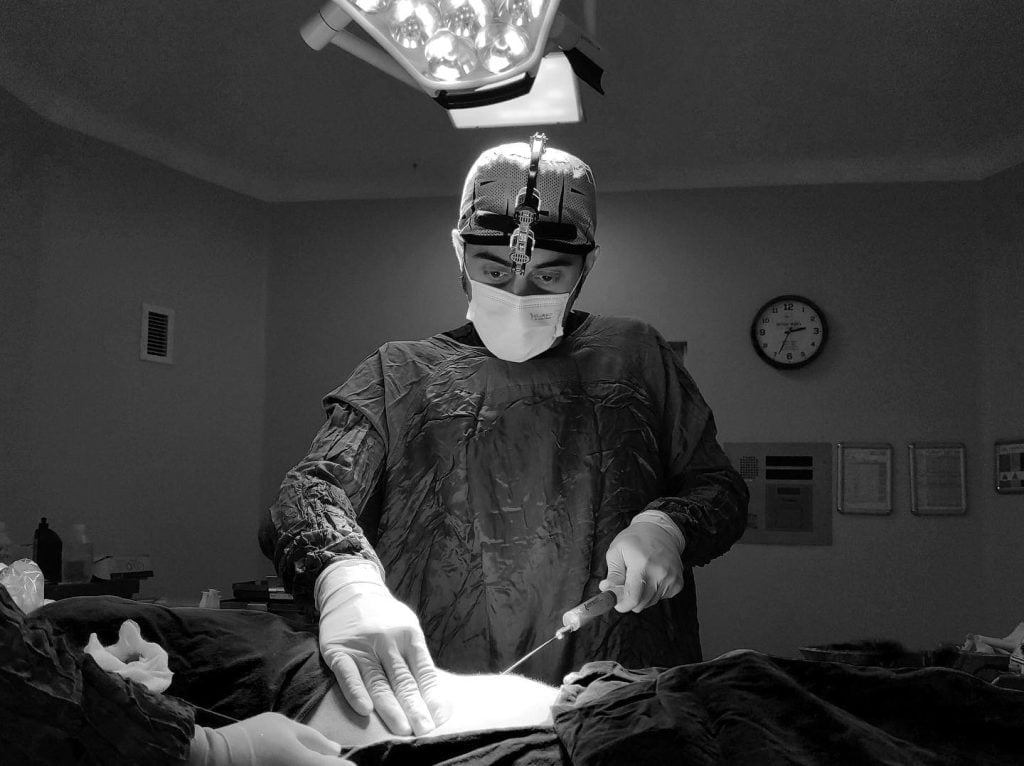
The Consultation Process with Dr. MFO: Your Personalized Journey
The journey towards eye feminization begins with a comprehensive consultation with me, Dr. MFO. During this initial meeting, we will discuss your aesthetic goals in detail, evaluate your facial anatomy, and determine the most appropriate treatment plan for you.
Here’s what you can expect during your consultation:
- Discussion of Your Goals: I will listen carefully to your concerns and what you hope to achieve with eye feminization surgery. Please feel free to bring photos of eyes that you find aesthetically pleasing to help illustrate your desired outcome.
- Medical History Review: I will review your medical history, including any previous surgeries, medical conditions, and medications you are currently taking. This is crucial to ensure your safety during and after the procedure.
- Facial Analysis: I will perform a thorough examination of your facial structure, paying close attention to the shape and position of your eyes, eyelids, brows, and surrounding tissues. I will assess your canthal tilt, the degree of upper eyelid hooding, brow position, and lower eyelid support.
- Treatment Options: Based on your goals and my assessment, I will discuss the various surgical and non-surgical options available to achieve your desired outcome. This may include upper blepharoplasty, brow lift, canthoplasty, canthopexy, lower blepharoplasty, and tear trough filler. I will explain the details of each procedure, including the techniques involved, the expected results, and the potential risks and complications.
- Customized Treatment Plan: Together, we will develop a customized treatment plan tailored to your individual needs and aesthetic goals. I will explain the recommended procedures, the order in which they should be performed (if multiple procedures are involved), and the expected timeline for recovery.
- Answering Your Questions: I will take the time to answer all your questions and address any concerns you may have about the procedures, the recovery process, and the expected results. It’s important that you feel fully informed and comfortable with your decision.
- Reviewing Before and After Photos: I will show you before and after photos of previous patients who have undergone similar procedures to give you a realistic idea of the potential results.
- Discussing Costs and Scheduling: We will also discuss the costs associated with the procedures and the scheduling options.
The consultation is an essential step in the process, as it allows us to establish a clear understanding of your goals and develop a personalized plan to help you achieve them.
Preparing for Eye Feminization Surgery: Ensuring a Smooth Experience
Proper preparation is crucial for a successful surgical outcome and a smooth recovery. I will provide you with detailed instructions tailored to your specific treatment plan, but general guidelines may include:
- Medical Evaluation and Clearance: You may need to undergo a medical evaluation by your primary care physician to ensure you are healthy enough for surgery.
- Medication Adjustments: You may need to stop taking certain medications, such as blood thinners and non-steroidal anti-inflammatory drugs (NSAIDs), for a period before and after surgery, as these can increase the risk of bleeding. Please provide a complete list of all medications and supplements you are taking.
- Smoking Cessation: If you are a smoker, you will be advised to quit smoking several weeks before surgery, as smoking can impair healing and increase the risk of complications.
- Avoidance of Certain Supplements: Some herbal supplements can also increase the risk of bleeding, so you may need to avoid them before surgery.
- Arrange for Transportation and Support: You will need someone to drive you home after surgery and stay with you for at least the first 24 hours to assist with your care.
- Prepare Your Home: Set up a comfortable recovery area at home with plenty of pillows, ice packs, and easy access to medications and other necessities.
- Follow Pre-Operative Instructions: Carefully follow all other pre-operative instructions provided by our office, such as fasting guidelines before anesthesia.
By following these guidelines, you can help ensure a safe and successful surgical experience.
The Eye Feminization Surgery Procedure: A Step-by-Step Overview
The specific steps involved in eye feminization surgery will depend on the procedures included in your customized treatment plan. Here is a general overview of what you can expect:
- Anesthesia: Most eye feminization procedures are performed under local anesthesia with sedation or general anesthesia, depending on the extent of the surgery and your comfort level. This will be discussed with you during your consultation.
- Incisions: Incisions are typically made in the natural creases of the eyelids to minimize visibility. For canthoplasty or canthopexy, a small incision is usually made in the outer corner of the eyelid crease. For upper blepharoplasty, the incision is made in the upper eyelid crease. For a brow lift, incisions may be made in the hairline or behind the ears, depending on the technique used.
- Tissue Manipulation: Depending on the procedure, the surgeon will then carefully remove excess skin and fat, reposition tissues, tighten muscles, or adjust the canthal tendon to achieve the desired outcome.
- Closure: Once the necessary adjustments have been made, the incisions are closed with fine sutures.
- Post-Operative Care: After the surgery, you will be monitored in the recovery room until you are stable enough to go home. You will be given detailed post-operative care instructions.
The duration of the surgery will vary depending on the number and complexity of the procedures performed. Typically, eye feminization surgery can take anywhere from one to several hours.
Recovery After Eye Feminization and Canthal Tilt Surgery: What to Expect
The recovery period after eye feminization surgery is crucial for achieving optimal results. Here’s what you can generally expect:
- Immediate Post-Op: Immediately after surgery, you will likely experience some swelling, bruising, and discomfort around the eyes. You will be given pain medication to manage any discomfort. Cold compresses are essential to help reduce swelling and bruising.
- First Few Days: During the first few days, it’s important to rest and keep your head elevated. Avoid strenuous activities, heavy lifting, and bending over. You will need to clean your incisions as instructed and apply any prescribed ointments or eye drops.
- Swelling and Bruising: Swelling and bruising will typically peak within the first week and then gradually subside over the following weeks. It’s important to be patient, as it can take several weeks or even months for all swelling to resolve completely and for the final results to become apparent.
- Suture Removal: Sutures are usually removed within 5-7 days after surgery.
- Return to Activities: You will be able to gradually return to your normal activities as you heal. Most people can return to work within 1-2 weeks, depending on the nature of their job and the extent of the surgery. However, you should avoid strenuous exercise for at least several weeks.
- Follow-Up Appointments: You will have follow-up appointments with Dr. MFO to monitor your healing progress and address any concerns. It’s important to attend all scheduled appointments.
- Sun Protection: Protecting your incisions from sun exposure is crucial during the healing process to prevent hyperpigmentation. Wear sunglasses and use sunscreen around the eyes.
It’s important to follow all post-operative care instructions carefully to ensure proper healing and minimize the risk of complications. If you experience any unusual symptoms, such as excessive bleeding, severe pain, or signs of infection, contact our office immediately.
Potential Risks and Complications: Understanding the Possibilities
As with any surgical procedure, eye feminization and canthal tilt surgery carry potential risks and complications. While these are rare when performed by an experienced and qualified surgeon like Dr. MFO, it’s important to be aware of them. Potential risks and complications may include:
- Bleeding and Hematoma: Excessive bleeding or the formation of a hematoma (a collection of blood under the skin) can occur.
- Infection: Infection at the surgical site is a possibility, although it is usually treatable with antibiotics.
- Poor Wound Healing or Scarring: While incisions are typically placed in natural creases to minimize visibility, there is always a risk of poor wound healing or the formation of noticeable scars.
- Dry Eyes or Excessive Tearing: Temporary or persistent dry eyes or excessive tearing can occur after eyelid surgery.
- Changes in Vision: Temporary blurred vision or, in very rare cases, more serious vision problems can occur.
- Asymmetry: It can be challenging to achieve perfect symmetry between both eyes, and minor asymmetries may persist.
- Numbness or Changes in Sensation: Temporary numbness or changes in sensation around the eyes can occur.
- Ectropion or Entropion: These conditions involve the lower eyelid turning outward (ectropion) or inward (entropion) and can sometimes occur after eyelid surgery.
- Lagophthalmos: This refers to the inability to fully close the eyelids, which can sometimes occur after upper blepharoplasty or canthoplasty.
- Need for Revision Surgery: In some cases, the desired outcome may not be achieved with the initial surgery, and revision surgery may be necessary.
- Specific Risks Related to Canthoplasty/Canthopexy: These may include over-correction or under-correction of the canthal tilt.
During your consultation, Dr. MFO will discuss these risks and complications in detail and answer any questions you may have. Choosing a board-certified and experienced facial plastic surgeon significantly minimizes these risks.
Achieving Natural-Looking Results: The Art of Subtle Transformation
The goal of eye feminization surgery is not to create an artificial or “overdone” look, but rather to achieve a natural and harmonious enhancement of your existing features. The art lies in making subtle changes that create a significant overall impact, resulting in a more feminine and attractive appearance that still looks like you.
Dr. MFO’s approach emphasizes a personalized treatment plan that takes into account your unique facial anatomy, your aesthetic goals, and the principles of facial harmony. The aim is to create a result that is both beautiful and natural-looking, enhancing your confidence and self-esteem.
Combining Eye Feminization with Other Facial Procedures: A Holistic Approach
Eye feminization can be effectively combined with other facial procedures to achieve a more comprehensive and balanced facial transformation. Some common procedures that are often performed in conjunction with eye feminization include:
- Facelift: A facelift can address sagging skin and wrinkles in the lower face and neck, creating a more youthful and rejuvenated overall appearance that complements the refreshed look of the eyes.
- Neck Lift: Similar to a facelift, a neck lift specifically targets sagging skin and fat in the neck area, improving the definition of the jawline and neck.
- Rhinoplasty (Nose Reshaping): The nose is a central feature of the face, and its shape can significantly impact overall facial harmony. Rhinoplasty can reshape the nose to better balance with the newly feminized eyes and other facial features.
- Facial Fat Grafting: Fat can be harvested from other areas of the body and strategically injected into the face to restore volume, smooth out wrinkles, and enhance feminine contours, such as in the cheeks and lips.
- Chin Augmentation or Reduction: The size and shape of the chin can influence the overall balance of the face. Chin augmentation or reduction can help create a more feminine facial profile.
- Lip Augmentation or Shaping: Fuller and well-defined lips are often considered a feminine feature. Lip augmentation with fillers or fat grafting can enhance the size and shape of the lips.
The decision to combine procedures will depend on your individual goals and the recommendations of Dr. MFO. A holistic approach to facial feminization can often yield the most satisfying and harmonious results.
The Psychological Impact of Eye Feminization: Boosting Confidence and Self-Esteem
Undergoing eye feminization surgery can have a profound and positive impact on an individual’s psychological well-being. Feeling more confident and comfortable with one’s appearance can lead to increased self-esteem, improved social interactions, and an overall enhanced quality of life.
For individuals transitioning genders, eye feminization can be a significant step in aligning their physical appearance with their gender identity, leading to a greater sense of congruence and well-being. Even for individuals who are not transitioning, achieving their desired eye shape can boost their confidence and make them feel more attractive and self-assured.
Choosing the Right Surgeon: Dr. MFO’s Expertise in Eye Feminization
Selecting a qualified and experienced facial plastic surgeon is paramount for achieving safe and successful eye feminization results. Dr. MFO is a board-certified facial plastic surgeon with extensive experience in performing a wide range of facial aesthetic procedures, including eye feminization and canthal tilt correction.
With a keen eye for detail, a deep understanding of facial anatomy, and a commitment to personalized care, Dr. MFO is dedicated to helping patients achieve their aesthetic goals with natural-looking and harmonious results. During your consultation, Dr. MFO will take the time to listen to your concerns, thoroughly assess your facial structure, and develop a customized treatment plan tailored to your individual needs and desires.
Dr. MFO’s expertise in the nuances of feminine facial aesthetics ensures that you will receive the highest level of care and achieve the beautiful and natural-looking eyes you desire.
Before and After Photos and Patient Testimonials: Real Results, Real Stories
While I cannot directly provide before and after photos or specific patient testimonials in this blog post due to privacy considerations, I encourage you to visit my website or schedule a consultation to view examples of my work and hear from satisfied patients who have undergone eye feminization surgery. These real-life examples can provide you with a better understanding of the potential results and the transformative power of these procedures.
Addressing Common Misconceptions About Eye Feminization
There are several common misconceptions surrounding eye feminization surgery. Let’s address a few of them:
- Misconception 1: It’s only for transgender individuals. While eye feminization is a popular procedure for individuals transitioning genders, it is also sought after by cisgender men and women who desire a more feminine or youthful appearance of their eyes.
- Misconception 2: The results look artificial. When performed by a skilled and experienced surgeon, eye feminization surgery should result in natural-looking enhancements that complement the individual’s overall facial features. The goal is subtle transformation, not an artificial appearance.
- Misconception 3: The recovery is very painful. While there will be some discomfort after surgery, it is usually well-managed with pain medication. The recovery period involves more swelling and bruising than severe pain for most patients.
- Misconception 4: It leaves noticeable scars. Incisions are strategically placed in natural creases to minimize visibility. Over time, these incisions typically fade and become barely noticeable.
- Misconception 5: It drastically changes your entire appearance. While eye feminization can have a significant impact on the overall femininity of the face, it is usually one component of a broader aesthetic goal. The changes are typically focused on the eye area.
Understanding the facts about eye feminization surgery can help you make informed decisions and have realistic expectations about the process and the results.
The Future of Eye Feminization Surgery: Advancements and Innovations
The field of facial plastic surgery is constantly evolving, with ongoing advancements in techniques and technologies. In the realm of eye feminization surgery, we may see further refinements in surgical approaches, the development of new minimally invasive techniques, and a deeper understanding of the nuances of facial aesthetics.
Continued research and innovation will likely lead to even more precise and predictable outcomes, further enhancing the ability of surgeons to help individuals achieve their desired feminine eye appearance.
Conclusion: Unlocking the Beauty of Feminine Eyes
Eye feminization and canthal tilt correction are powerful procedures that can significantly enhance the femininity and overall attractiveness of the face. By understanding the principles of feminine eye aesthetics, the concept of canthal tilt, and the various surgical and non-surgical options available, individuals can make informed decisions about their aesthetic journey.
If you are considering eye feminization surgery, I encourage you to schedule a consultation with me, Dr. MFO. Together, we can discuss your goals, assess your facial anatomy, and develop a personalized treatment plan to help you achieve the beautiful and natural-looking eyes you have always desired. The eyes truly are the windows to the soul, and with the art of facial plastic surgery, we can help them reflect the beauty and confidence within.

Schedule Your Consultation with Dr. MFO Today
Visit Dr.MFO Instagram profile to see real patient transformations! Get a glimpse of the incredible results achieved through facial feminization surgery and other procedures. The profile showcases before-and-after photos that highlight Dr. MFO’s expertise and artistic vision in creating natural-looking, beautiful outcomes.
Ready to take the next step in your journey? Schedule a free consultation with Dr. MFO ( Best Facial Feminization Surgeon for You) today. During the consultation, you can discuss your goals, ask any questions you may have, and learn more about how Dr. MFO can help you achieve your desired look. Don’t hesitate to take advantage of this free opportunity to explore your options and see if Dr. MFO is the right fit for you.

